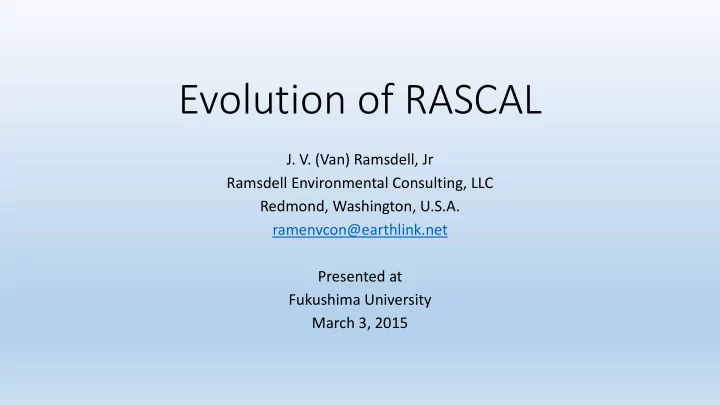

Evolution of RASCAL J. V. (Van) Ramsdell, Jr Ramsdell Environmental Consulting, LLC Redmond, Washington, U.S.A. ramenvcon@earthlink.net Presented at Fukushima University March 3, 2015
Pre RASCAL Development • Atmospheric Transport and Dispersion • Process modeling (dispersion parameters, plume rise, etc.) for Gaussian plume models. • Start and Wendell (1974) • U.S. NRC Emergency preparedness guidelines (1980) • MESOI (1981,1983) • MESORAD (1986, 1988) • Source Term Estimation • Reactor Safety Study (1975) • Severe accident training manual, McKenna et al. (1987) • Severe accident source term estimation, McKenna and Gitter (1988)
RASCAL Evolution • RASCAL 1.3 (1989) - Minicomputer • RASCAL 2 (1993, 1994, 1997) – DOS, PC, Laptop • RASCAL 3 (2001, 2007) – Windows, full temporal and spatial variation of meteorology, potential flow wind field model, low wind speed correction, UF6 model • RASCAL 4 (2012) – Updated source term release sequence, initial Fukushima source term estimates, improved dispersion and deposition parameters, intermediate phase dose estimates • RASCAL 4.3.1 (2014) – LTSBO fuel release model, improved release path definition, extended release duration, multi-unit consequence assessment, extended domain (160 km radius), automated meteorological data acquisition.
Development Process • Initial development of source term and atmospheric models was independent • Combination of source term, atmospheric, dose calculations in RASCAL required a cooperative development effort • Feedback from consequences assessment team (RASCAL users) dictated that the RASCAL development be expanded to include key members of the consequences assessment team as consultants related to addition or removal of components and development of the user interface
Model Developer Lessons Learned • Model only those processes and phenomena that significantly affect consequences • Limit required input to readily available information • Provide default values for all parameters entered by users • Keep primary output simple and related to protective action criteria • Provide regular training for users • Provide comparisons with other models • Do not oversell the accuracy of the model
RASCAL User Lessons Learned • Participate in RASCAL training and provide feedback to developers • Learn and understand the language of RASCAL • Make realistic, not worst case, estimates of consequences • Control dissemination of RASCAL output during an event • Provide decision makers with timely estimates of consequences • Assist decision makers by focusing input to decision makers on the decisions to be made.
The Message • Successful consequence assessment tool development is a team effort requiring participation of both model developers and consequence assessment tool users.
Recommend
More recommend